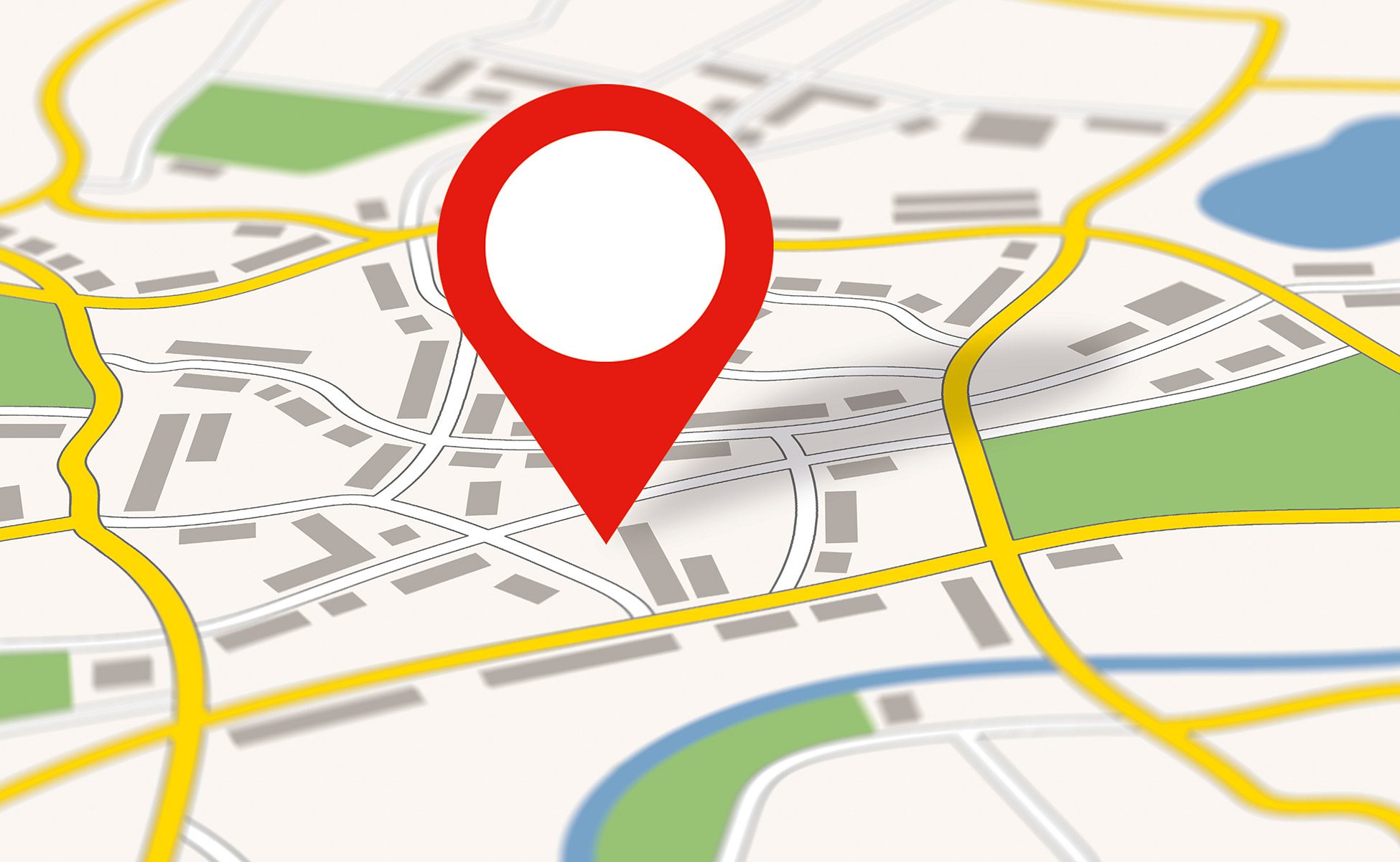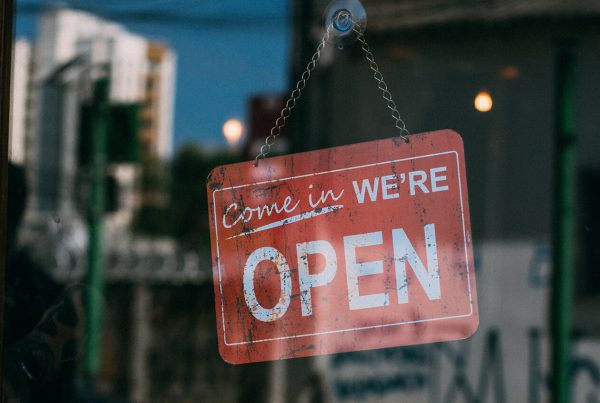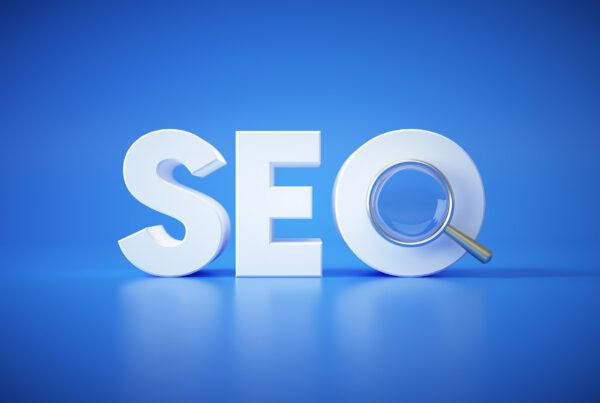Don’t have time to read the full blog? Check out our short recap below.
How do I rank higher on Google Maps?
- Claim and verify your Google Business Profile (GBP) listing
- Fully complete your GBP listing
- Ensure your GBP category is accurate
- Add lots of high quality photos
- Acquire relevant Google reviews
- Make posts on your GBP regularly
- Learn more about Local SEO factors that affect your rankings
- Use SEMrush’s Position Tracking to monitor how you rank for your most important local keywords
- Find a digital marketing partner like us to help you rank higher with less stress. Simply schedule a call and we’ll take it from there.
How to Rank on Google Maps
Ranking well on Google Maps can be monumental for local businesses. More and more people are taking to search engines to find local information. In fact, SEO Tribunal reports that 97% of people learn more about a business online than they do anywhere else.
The age-old assumption that word of mouth is king is beginning to fade.
Not only do most people learn about local businesses online, but 84% of Google users conduct local searches on a regular basis (think “hvac repair near me”). Consumers are searching for local information on a regular basis. Believe it or not, people are searching for more than just funny videos and pictures of puppies – and it has huge implications for local business.
Two Ways to Search for a Local Business
One way someone might perform a local search is directly on Google Maps – perhaps on the Google Maps app or within their browser.
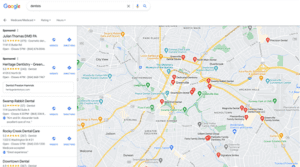
This type of search will display around 20 locations on the map and in the left hand sidebar. Note that these are not necessarily websites, though many contain a link to the business’s website.
These are Google Business Profile listings, which are critical to ranking in maps…but more on that later.
When most marketers think about ranking in Google Maps, we think about the local pack (sometimes called the “map pack” or “snack pack”).
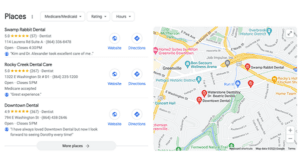
This is a search feature Google rolled out years ago to help people find local businesses that match their search queries. The map pack always displays 3 local businesses (with an occasional advertisement squeezed in).
What Searches Display the Local Map Pack on Google?
Whether you realize what they were called or not, you’ve most likely seen and interacted with a local map pack on Google.
A local map pack will show on a search results page just about every time Google registers local intent. In other words, if Google thinks a searcher wants a local result, they will display the local pack.
Local Specific Searches
Of course, Google will also show a local pack when you specify a city or region in your search. “Apple pies in Greenville, SC” will almost always trigger the map.
Google’s local map will also display without the user specifying a city.
Local Intent Searches
Google has become smart enough to know when we’re looking for a local result, even when we don’t specify.
For an informational search, like “how to bake an apple pie,” you don’t need recipes from a local business, any recipe will do.

On the other hand, for a transactional search like, “where to buy a fresh apple pie,” Google will recognize you’re in need of a local business. This is why you should have a Google Business Profile and keep it up to date.
Google Business Profiles: The Key to Ranking in the Local Pack
Google Business Profile is a free profile that allows businesses to appear in Google Maps and engage with customers for free.
Whether or not you know it by name, you’ve likely seen and used a Google Business Profile listing. Google Business Profiles are the bread and butter of local search and play a huge role in whether or not you rank well for local searches.
Your Google Business Profile contains:
- Business name
- Business category
- Phone number and address
- Website link
- Reviews
- Business images
- Popular times to visit
If a user clicks on a result in the local pack (not on “Website”) they are taken to that company’s Google Business Profile listing.
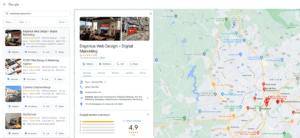
If a user types in a brand name, they are also likely to see that company’s Google Business Profile listing on the right-hand side of the search results page.
How to Improve Your Google Business Profile Ranking
Now that we understand the local map pack and Google Business Profiles, let’s talk about how to rank in the local map pack. There are many factors to consider, and depending on your industry, some factors are a little more important than others.
Each year, local SEO company Whitespark polls a bunch of local SEO experts and puts together the Local Search Ranking Factors survey. In short, they ask around 50 of the top local search experts what factors they’ve noticed impacting local results most that year.
Here’s a shortlist of the top 7 factors from the 2023 survey:

What factors affect your Google Maps rankings?
- Google Business Profile: Your GBP and how it’s optimized (or not optimized)
- Your Website’s On-Page Optimization: How your site is optimized, and more specifically, the page linked from your website link in your GBP
- Reviews: Quality and quantity of reviews on your GBP
- Backlinks: Quality, quantity, and local relevance of backlinks to your website
- Behavioral Signals: How users interact (or don’t interact) with your GBP
- Citation Signals: Quality, quantity, and relevance of business listings across the web (where your business’s name, address, and phone are listed – on a directory site like Yelp, for example)
- Personalization: The user’s location, search history, and other factors that influence how Google might personalize the search results for a searcher
Let’s dive into each of these:
Optimizing Your Google Business Profile
Claim (or Create) Your Profile
Google your business name. Do you see your business appear on a right-hand panel? If so, look for an “own this business?” prompt. If you don’t see it, this means someone has claimed it—perhaps someone in your office or an old web provider. Ask around to see if someone has claimed it.
If you can’t locate the owner, you can request ownership through Google to reclaim your business. Once you do this, the current owner will receive an email and have 14 days to respond. Otherwise, you will have the opportunity to claim it as your own.
If you don’t have a Google Business Profile at all, you can create one here. Or let us build one for you—we create Google Business Profiles for all of our SEO clients.
Complete Your Google Business Profile
What GBP elements should you fill in?
- Name
- Business Category (primary and secondary)
- Phone number
- Hours
- Address
- Photos (front of your building, inside your office, and your team at minimum)
- Description (a great place to pitch yourself)
- Any relevant attributes (these will depend on your business category)
Keep all your information as consistent as possible with what is displayed on your website. If your address on your website is listed as Smith Street, don’t use Smith St. (Google rewards consistency). Google will probably normalize this data and figure it out, but it’s unwise to make the Google bots work if they don’t have to!
Choose the Best Primary Category for Your Profile
Your Google Business Profile category is likely an after-thought, but not selecting the best category can be detrimental. Google allows you to set a primary category as well as secondary categories, but the primary category carries much more weight.
A recent client in the roofing industry came to us with the primary category of “Corporate Office” for years. This crushed their ability to rank locally for anything related to roofing. A simple category switch tripled their discoverability in Google Maps.
For most businesses, this is a pretty simple decision. For instance, a personal injury attorney who practices by themselves in a single location has an easy decision. But a law firm with many attorneys in a variety of practice areas has a much tougher one.
Here are a few tips to think through if your business could fall into multiple categories:
- Consider:
- the service for which you’re most well known
- the service most in need of new customers
- seasonality (optimize for heater repair in the winter and AC repair in the summer)
- If you have multiple practitioners, create separate listings for each practitioner (each attorney has their own GBP with their specific category)
Add Lots of High Quality Photos
Google Business Profiles allows you to visually show off your business to consumers, and everyone loves good photos. In fact, 60% of consumers said that local search results with good images captured their attention.
We recommend a few specific images, at minimum:
- Your logo
- The outside of your building (help people know what to look for)
- The inside of your space
- Your team
- Your team working with customers
Acquire Quality Google Reviews
Reviews are absolutely vital for small businesses. Not only do they play a big role in local SEO, but consumers consult online reviews more than ever before. 86% of consumers read reviews of local businesses and 57% of consumers say they will only use a business if it has 4 or more stars.
How to get more reviews, you ask? Consider your consumer cycle and insert a review ask at some point in the process. This can come in the form of an email, a written letter, or through a reputation management service like Grade Us.
In addition to helping consumers make purchasing decisions, reviews send all kinds of signals to Google. A business with 50 positive reviews is going to look better than a business with 20—if you do better work. Unfortunately, Google isn’t in your business watching you do it.
How do you determine a “good” number of reviews? Google your industry and location (for us this looks like “digital marketing greenville sc”) and take a look at your competition. You don’t necessarily need double that of your competition, but we would recommend being in the same ballpark as your competitors.
What’s a quality review? A review that contains specifics of what services you provided. Bonus points if your reviewer uses a relevant keyword–Google really likes this!
Google often pulls comments and phrases out of Google reviews to give context to the user and help you rank for different queries.
Respond to Reviews
89% of consumers say they read business’s responses to reviews.
Google is often the first place shoppers will go to check out a business before making a purchase. Use your Google reviews as a place to interact with your customers and show off your human side.
You don’t have to respond to all your positive reviews, however, you should respond to a large majority in a personal way. And you should always respond to all negative reviews. Contrary to popular belief, negative reviews give you a great opportunity to recover in a graceful way for all to see.
Make Posts
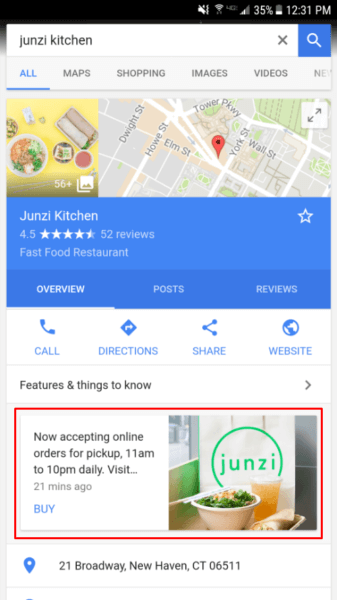
They’re an easy way to let your audience know of recent news, offers, deals, products, or simply a recent blog you’ve published. Include a photo and a link to learn more. Any time you put out new content, add a new offer/deal, or roll out a new product, you should add a post about it.
There aren’t any conclusive studies, but many local marketers think regularly posting relevant posts containing keywords you want to rank for can increase local rankings.
Promote Your Events
Similar to posts, GBP allows you to promote your events.
This is a great way to spread the word and increase your event attendance. In addition to posting your events on your website and social accounts, use GBP to boost event visibility.
In addition to gaining visibility, regular events send positive signals to Google that you’re active in the community and a real, boots-on-the-ground local business.
Answer Questions
GBP allows anyone to ask a question about your business on your listing. Google also lets the community answer these questions.
You should be vigilant about checking for new questions and answering them as they come in.
You don’t want to risk someone else answering the question with false information. It also helps that the activity is a positive ranking signal.
On-Page Optimization
Though the Google Business Profile is the most important factor when it comes to local map rankings, your website matters as well. While there are some GBP’s that will rank without a website at all, having a well-optimized website helps tremendously.
Here’s how to make sure your on-page optimization is in check:
- Localized Content: Ensure that the content on your landing page is localized. This means it should be relevant to the local audience you’re targeting. If you’re a restaurant in Austin, for example, mention signature dishes that cater to local tastes, or perhaps touch upon local events or festivals where you might have a presence.
- NAP Consistency: Your Name, Address, and Phone number (NAP) should be consistent across your GBP and your website. Inconsistencies can confuse search engines and lead to a drop in rankings.
- Schema Markup: Implementing schema markup (Local Business Schema) helps search engines understand your content better, allowing them to present it more effectively in local searches. (Think SEO code to help the internet bots process your company’s data more effectively).
- Mobile Optimization: A significant portion of local searches are conducted on mobile devices. Your landing page must be mobile-friendly to cater to this audience.
- Page Speed: If your landing page takes too long to load, not only will potential customers bounce off, but Google might also penalize you in rankings.
- Relevant Keywords: While you don’t want to stuff your content with keywords, it’s essential to include the keywords you want to rank for on your site – especially on your landing page.
- Internal Linking: Ensure that your landing page is well-integrated with the rest of your website. This can be achieved through effective internal linking.
Backlinks
Though they carry far more weight when it comes to organic (non-map) rankings, backlinks play a big role in influencing local search rankings. Here are a few things to consider:
- Quality: A link from a trusted, authoritative website carries more weight than numerous low-quality links. One well-regarded backlink can be more beneficial than dozens from lesser-known sites.
- Quantity: While quality trumps quantity, having a good number of quality backlinks signals to search engines that your website is a valuable resource.
- Local Relevance: For local SEO, backlinks from local businesses, news outlets, or community websites are invaluable. They emphasize your connection to the community, bolstering your local credibility and relevance in the eyes of search engines.
Behavioral Signals
Google doesn’t solely rely on what businesses say about themselves; it heavily considers how users interact with a business’s Google Business Profile. This is captured through behavioral signals. Here’s how they factor into your local ranking:
- Engagement Rate: If users frequently click on your business listing, leave reviews, or engage in other interactions like seeking directions, it showcases genuine interest in your business. Such actions can bolster your standing in local rankings.
- Clicks for Relevant Keywords: When a user searches for a term related to your business and clicks on your GBP, Google perceives it as a positive signal that your listing matches the user’s intent. Over time, consistent clicks for relevant searches solidify your position as a top result for those queries.
- Bounce Rate: If users frequently click on your GBP but quickly return to the search results, it might indicate that they didn’t find what they were expecting or looking for. High bounce rates can negatively impact your local rankings.
- User Check-ins & Photo Uploads: When customers check-in or upload photos of your establishment, it not only validates your business’s authenticity but also signals to Google that patrons are engaging with and endorsing your business.
These are tough to “optimize” for, but in general, keep your Google Business Profile updated, compelling, and engaging. (And operate a great business – that always helps.)
Local Citations
Citations refer to the instances where your business’s Name, Address, and Phone number (NAP) are mentioned across the web. They play a critical role in local SEO for several reasons:
- Consistency: A uniform NAP across various platforms and directories reinforces your business’s authenticity. Google values this consistency, as it provides assurance that the information presented is accurate and trustworthy.
- Quantity: The sheer quantity of citations can enhance your local SEO. A business with numerous mentions across trusted local directories, websites, or platforms might be deemed more prominent and hence worthy of a better local rank.
- Relevance: Citations from locally recognized platforms or community websites underline your ties to the community. These locally relevant citations can significantly boost your local standing.
Personalization and User Behavior
Google’s primary goal is to deliver the most relevant results to its users. Personalization plays a central role in achieving this, ensuring users receive search results aligned with their preferences, behaviors, and context:
- Location: Google often tweaks search results based on the searcher’s location. For local businesses, this means a user nearby might see your business ranked higher than someone searching from a distant location.
- Search History: Google considers the user’s past searches to gauge their interests. If someone frequently searches for vegan restaurants, for example, they might see more vegan dining options in a search for “restaurants near me.”
- User Behavior: If a user often clicks on, spends time on, or revisits a particular website or business profile, Google might prioritize those results in future searches, recognizing a preference.
- Device Type: The type of device used, be it mobile or desktop, can also influence the search results displayed, with mobile-optimized businesses ranking higher for mobile users.
Unlike many of the other factors, this one can’t really be optimized for. But much like behavioral signals, operating a great business, offering fair prices, and providing excellent service always helps.
Take Advantage of Google Maps
There are a lot of marketing options for local businesses. One could spend thousands on billboards, local television commercials, magazine ads, etc…Of all the marketing tactics, setting up a Google Business Profile profile and taking 30 minutes a month to update it might just be the cheapest (hello, it’s free) and easiest way to move the needle.
Maybe you have an optimized Google Business Profile listing, but it’s still not ranking well. Our team would love to chat.
Start the Conversation
Interested in ranking better online, generating more leads, and increasing your visibility with customers? Take a look at our Digital Marketing services today.
